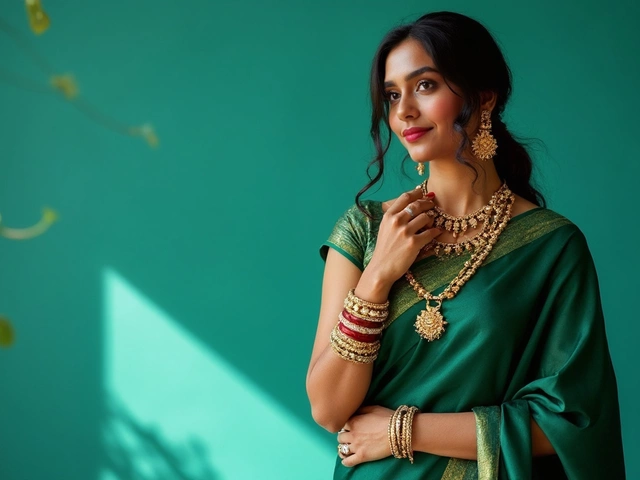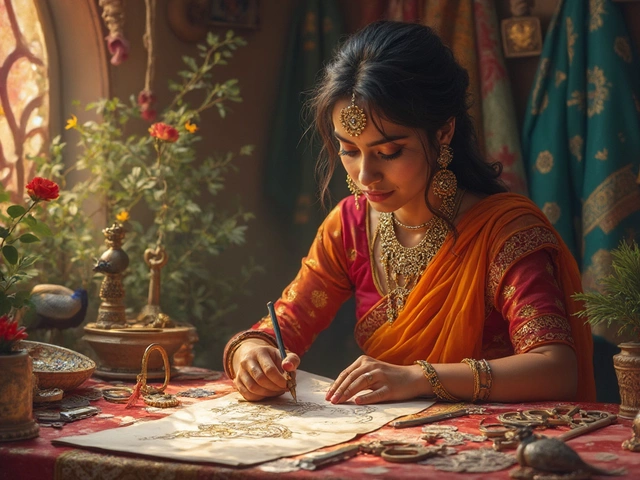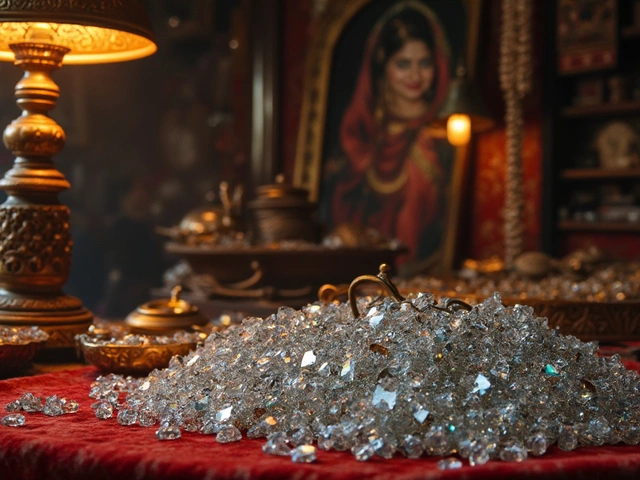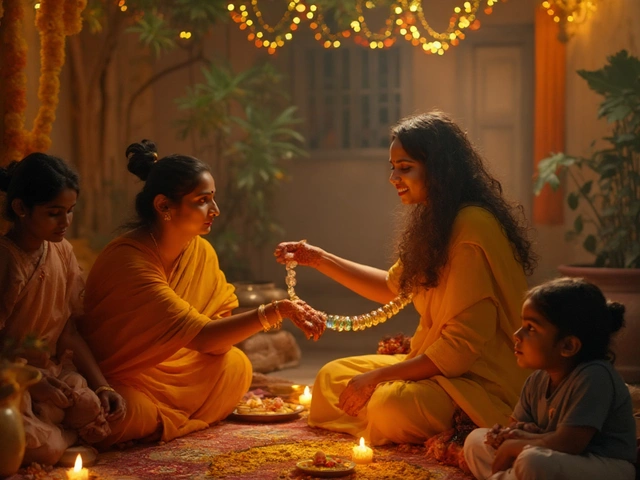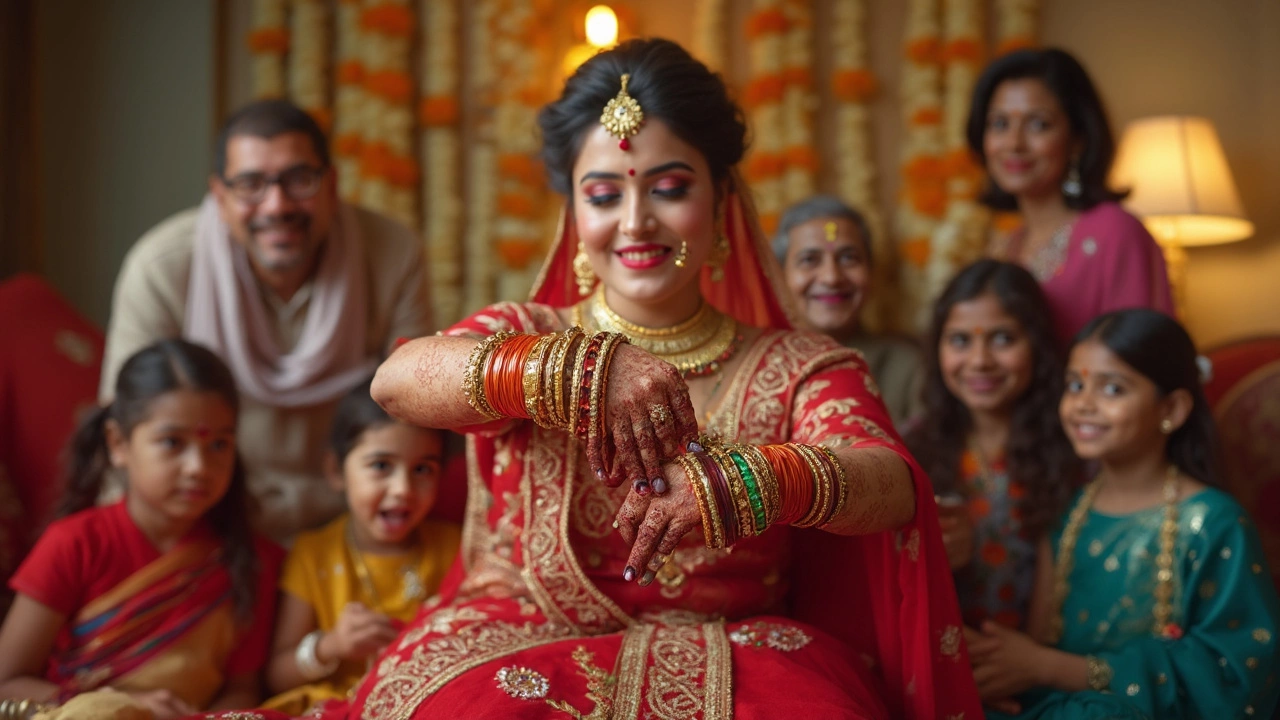
People often think brides just wear their bangles for the wedding photos and move on, but that’s not the case in most Indian traditions. Bangles aren’t just jewelry—there’s meaning packed into every clink and color. For many brides, these bangles are a sign of their newly-married status, and the rules around how long they should wear them are surprisingly detailed.
Let’s get real: you’ll hear “it depends” a lot in India. For example, in the North, Punjabi brides often wear a set called a ‘chooda’ for anywhere from 21 days up to a year, depending on how traditional the family is. Other regions have their own timelines and types—so don’t be surprised if your cousin in Mumbai is doing things differently than your aunt in Delhi.
- The Symbolism Behind Bridal Bangles
- How Long Do Brides Keep Bangles On?
- Regional Differences That Matter
- Everyday Care and Real-Life Tips
The Symbolism Behind Bridal Bangles
It’s not just about looking good—Indian bangles have real meaning in a wedding. For starters, bangles are a loud, colorful reminder that someone just got married. The red and white ‘chooda’ set, common in Punjabi weddings, is probably the most talked-about set of bridal bangles, but every region puts its own stamp on things. In Bengal, brides often wear gold and red bangles called ‘shakha pola,’ while South Indian brides may go heavy with green glass bangles.
The colors aren’t random. Red means energy and prosperity, while white stands for new beginnings. Green glass bangles are thought to bring fertility and luck. And those thick stacks? They’re meant to make noise, so wherever the bride goes, people know she’s just married. If you’re thinking these traditions sound old, you’re right—some of these go back hundreds of years, and there’s usually a practical reason behind the style. In some families, the length and size of wedding bangles even show how close-knit a family is—longer stacks, more celebration.
Here’s a quick look at some common bridal bangle sets and what they symbolize:
- Chooda (North India): Red and white, symbolizing prosperity and marital happiness.
- Shakha Pola (Bengal): White (conch shell) and red (coral), standing for purity and energy.
- Green Glass (Maharashtra, South India): Linked to fertility and good fortune.
The act of putting on these bangles is just as important. Usually, it’s done by the bride’s maternal uncle and aunt, making it a unique family bonding moment. For many families, it’s not a real wedding without this step, and breaking a bangle by accident can feel like a bad sign—even though most people try to shake off that old-school belief.
For anyone looking to honor tradition, these bangle tradition details are way more than just a style statement—they’re packed with meaning, and every region brings something different to the table.
How Long Do Brides Keep Bangles On?
This question pops up all the time, and there’s no single answer. It really depends on where you’re from and how your family rolls with traditions. Let’s break it down by the most common practices with Indian bangles for brides.
For Punjabi weddings in North India, the red and white bridal bangles called chooda are a big deal. Traditionally, brides wear their chooda for a whole year after the wedding, but now it’s common to see women keeping them on for 40 days or just up to their first big festival as a married woman. Family expectations and comfort really shape the decision.
In Gujarat, new brides often sport green glass bridal bangles for about 40 days. Meanwhile, Maharashtrian brides stick to green and gold bangles, usually for three to six months. In South India, the style changes, but the idea is similar—bangles are worn at least until the first major ritual or festival after the marriage. Some Tamil brides keep their gold and glass bangles on for an entire year for good luck.
Here’s a quick look at some of the different traditions:
- Punjab: Chooda for 40 days to 1 year
- Gujarat: Green bangles for 40 days
- Maharashtra: Green-gold bangles for 3–6 months
- South India: Usually until first big festival, sometimes up to a year
If you ask around today, a lot of brides end up choosing what works for them—sometimes blending family rules with what feels comfortable in daily life. Practical stuff like work policies, travel, or even how heavy the bangles are can influence how long they stay on.
Fun fact: in some Sikh and Hindu Punjabi families, there’s an extra ritual where the bride’s in-laws remove one or two chooda bangles as a kind of blessing, which makes the whole timeline a bit more flexible.
| Region | Type of Bangles | Typical Duration |
|---|---|---|
| Punjab | Chooda | 40 days - 1 year |
| Gujarat | Green Glass | 40 days |
| Maharashtra | Green & Gold | 3-6 months |
| South India | Gold/Glass | 1 festival - 1 year |
End of the day, there’s no hard-and-fast rule for how long to wear your bridal bangles. It’s about finding the sweet spot between tradition and practicality. If you’re a bride (or know one), it’s all about doing what feels right—and maybe keeping Mom and grandma happy at family dinners.
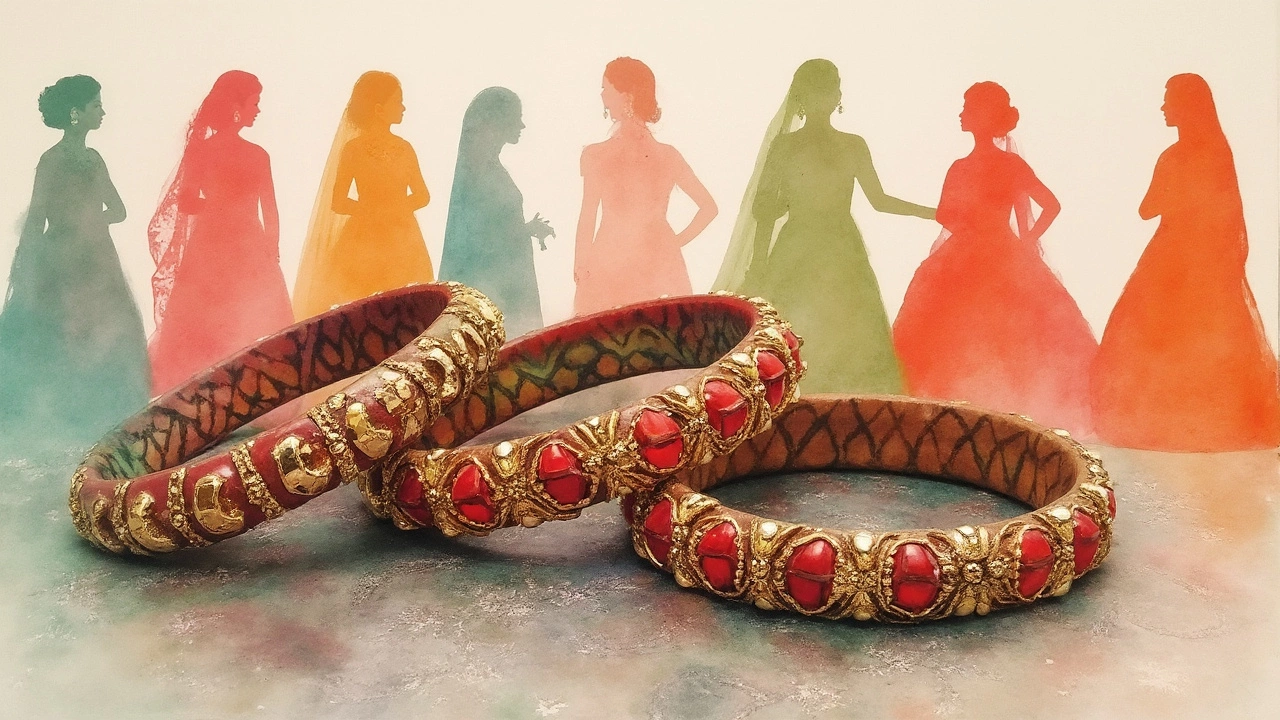
Regional Differences That Matter
There’s no single rulebook when it comes to how long Indian brides wear their Indian bangles. Every region—and sometimes every family—does it their own way. Let’s break down some of the biggest differences that actually matter if you’re getting married or trying to respect local traditions.
Punjab is famous for the red and white chooda. Here, brides usually keep their bridal bangles on for 40 days, but in some families, it’s stretched to six months or even a full year. There’s even a little ceremony called ‘chooda-wadhana’ for when she finally takes them off. Some families cover the bangles for the first few days with a cloth, which is only lifted by the groom on a special day.
If you go toward Gujarat and Maharashtra, brides mix green glass bangles with gold ones. In Maharashtra, the green bangles (representing fertility) are usually swapped for something more practical after about a month. No big ceremony—just a quiet transition as she gets used to married life.
Bengal brides don’t do the chooda, but they have the shankha pola—white and red bangles made from conch shell and red corals. Traditionally, these are worn for as long as the woman is married, not just right after the wedding. It’s more permanent than symbolic, and widows are expected to take them off.
Down south, things are a little more relaxed. In Tamil Nadu and Karnataka, gold bangles—sometimes called ‘valayal’—take center stage. There’s no set timeline; some brides wear them for a few weeks, while others just use them as part of the wedding look. It’s totally personal, and you won’t see grand rituals for taking them off.
If you want a fast look at the variety across India, check this out:
| State/Region | Type of Bridal Bangle | How Long Worn |
|---|---|---|
| Punjab | Chooda (red/white) | 40 days to 1 year |
| Maharashtra | Green glass/gold | About 1 month |
| Bengal | Shankha pola | Entire married life |
| Tamil Nadu/Karnataka | Gold/valayal | Few weeks/as desired |
Bottom line? If you’re a bride (or planning for one), check in with the elders, because there’s no “one size fits all” when it comes to wedding customs around bangle tradition in India.
Everyday Care and Real-Life Tips
Wearing bridal Indian bangles every day isn’t always a walk in the park. They’re delicate, prone to scratches, and attract dust way faster than you’d expect. If you want your bridal bangles to look good until it’s time to take them off, you’ve got to treat them right.
First off, steer clear of water as much as possible. Bathing, washing dishes, and constant handwashing can cause the color, especially on glass or lacquer bangles, to fade. It won’t happen overnight, but after a few weeks, you’ll see a difference. If you have to deal with water, keep a soft towel handy so you can pat them dry right away.
Sleeping with bangles on? Most new brides do, but there’s a trick to keeping them from breaking at night: wear a soft cloth band or scrunchie over them to keep them close together and stop rubbing. And if you’re typing a lot on your laptop or cooking, consider sliding off a few bangles—just remember to check if your customs let you remove them for short breaks.
- When storing traditional Indian bangles, use a padded box or dedicated bangle stand. Never just toss them in with other jewelry or they’ll get scratched.
- If you notice any skin irritation, dab a bit of coconut oil between the bangles and your wrist. This is especially helpful in the hot months or if you have sensitive skin.
- Wipe glass bangles gently with a soft, dry cloth. For metal or gold ones, use a mild jewelry cleaner, but avoid chemicals if your bangles have enamel or stones glued on.
Some brides go the extra mile by having a couple of plain colored or plastic bangles for household chores, so they can swap out the real set and keep it safe. No judgment—nobody wants to lose a precious chooda to the sink or a stubborn kitchen cupboard.
And remember: if a bangle breaks, especially early on, don’t panic. In most parts of India, it’s just a hiccup, not a bad omen. Accidents happen, and replacements are easy to find—just try to match the color closely so it blends in.
| Bangle Type | Best Cleaning Method | Durability (1-10) |
|---|---|---|
| Glass | Soft dry cloth | 5 |
| Lacquer | Gentle wiping, avoid water | 6 |
| Metal (Gold/Silver) | Mild jewelry cleaner | 8 |
Maintaining your wedding bangles is really about being mindful during your daily routine. Treat them like the symbol they are, and they’ll last as long as your family expects—or until you’re ready for a new tradition.

